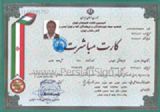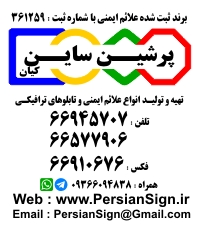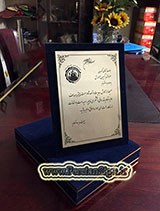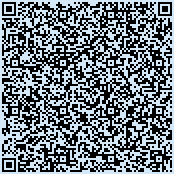1. CHANGE: Conformance with ISO 3864-1 & 2 Standards
One of the major changes taking place in this standard is the approval or acceptance by ANSI of all the ISO 3864-2 formatted safety signs as a valid option for product safety labels in the US.
3.1.1 ISO-formatted safety signs: Product safety information may be conveyed by ISO formatted safety labels in compliance with ISO 3864-2,Graphical Symbols - Safety colors and safety signs - Part 2: Design principles for product safety labels. from ANSI Z535 2007
Product Safety Labels using the signal words shown on the Illustration 1.1 below, can only be used on equipment sold in the USA and Canada, because they lack several components to comply with the international standards for equipment labeling (ISO 3864).
Illustration 1.1 ANSI Z535.4 2002 & 2007 Compliant Safety Labels
Product Safety Labels using the signal words and surround shape safety symbols shown below on the Illustration 1.2 are in compliance with ISO 3864-2 Standard (as long as the safety symbol is contained in a surround shape like a yellow triangle, prohibition circle, or blue circle; and the safety alert symbol seen on the signal word is within a yellow triangle.
Illustration 1.2 ANSI Z535.4 2007 & ISO 3864-2 Compliant Safety Labels
2. CHANGE: Safety Alert Symbol Use and Colors
Another change worthy of note is the clarification of the Safety Alert Symbol; use and respective colors and the incorporation of the ISO 3864-1 version. In the last revision, 2002, it only supplied a explanation of what the symbol should be and what it meant. This new revision (2007) on the other hand has taken a step further into clarifying when to use, how to use, what colors it should be, and also the option(s) that when used on the ANSI safety labels will be in compliance with ISO 3864-2.
4.10 Safety Alert Symbol: a symbol which indicates a potential personal injury hazard. It is composed of an equilateral triangle surrounding an exclamation mark. The safety alert symbol shall not be used to alert persons to property-damage-only accidents. from ANSI Z535 2007
- Danger
- for use with DANGER signal word: white triangle, red exclamation mark and red bkgd.
- Warning
- for use with WARNING signal word: black triangle with orange exclamation mark.
- Caution
- for use with CAUTION signal word: black triangle with yellow exclamation mark.
- Danger, Warning, Caution Black border
- for use with DANGER, WARNING or CAUTION signal words: yellow background, black border and black exclamation mark
- Danger, Warning, Caution Yellow border
- for use with DANGER, WARNING or CAUTION signal words: yellow background, black border and black exclamation mark with a yellow border around the black border.
3. CHANGE: Review of the existing signal words and addition of NOTICE as a new signal word for product safety labels
This third change is the addition of "NOTICE" as a signal word for product safety labels to identify property-damage-only situations. The use of "CAUTION" (without exclamation mark) the to identify property-damage-only situations is still allowed, but as an alternate option to "NOTICE"
The 2002 revision stated that the signal words for product safety labels were: DANGER, WARNING, CAUTION. Where CAUTION could be used for property-damage-only accidents when used without the triangle and exclamation mark.
ANSI Z535 2007 Revision, Signal Word Definitions:
DANGER: Indicates a hazardous situation which, if not
avoided, will result in death or serious injury. This signal word is
limited to the most extreme situations.
WARNING: Indicates a hazardous situation which, if not avoided, could result in death or serious injury.
CAUTION: Indicates a hazardous situation, which if
not avoided, could result in minor or moderate injury. It may also be
used without the safety alert symbol as an alternative to "NOTICE"
NOTICE: is the preferred signal word to address
practices not related to personal injury. The safety alert symbol should
not be used with this signal word. As an alternative to "NOTICE", the word "CAUTION" without the safety alert symbol may be used to indicate a message not related to personal injury.
Sign Classification: Hazard Classification (Signal Words)
The first element to consider when designing a product safety label is to determine the likelihood and severity of a potential injury if a person does not follow the instructions contained on the safety label or sign. For product identification there are four Signal Words or Hazard Classifications used in the design of an ANSI Z535.4 2007 compliant safety label: "DANGER", "WARNING", "CAUTION" or "NOTICE"
When more than one hazard exists on a product it is permissible to use one label, provided the information addresses each hazard and the signal word selected is based on the greatest level of hazard.
Safety Alert Symbols are used to warn of a potential personal injury hazard. This symbol is used in conjunction with the signal word or can be used alone. This symbol should be used on both product safety labels and in literature which can describe the potential hazard in greater detail.
Formatting of ANSI Z535.4 Product Safety Labels:
Please note that ANSI Z535.4 requires all safety labels to have the
following components: a signal word panel (signal word must have a
preceding safety alert symbol) plus a message panel. A safety symbol
panel may be used to communicate parts, or all, of the elements of a
message panel.
ANSI Label Format
ANSI requires a product safety label to have a certain amount of
information, which can not be covered or contained in one single image
representing the hazard and the avoidance of it, as ISO's approach of
one singlesymbol label does. ANSI Z535.4 2002 encourages product
manufacturers to include and use safety symbols as part of the label
content, but the use of a symbol is still optional in this standard,
while ISO's use of safety symbols, wether as a single-symbol product
safety label or a combination label with supplementary text is
mandatory.
Safety Label: Message Panel Format?
The message panel of any new ANSI Z535.4 2007 compliant sign or label must contain: Identification of the hazard, identification of a means to avoid the hazard, and the consequences of not avoiding the hazard. The order that the information appears in the message panel is flexible and should be determined by logical factors related to avoiding an injury, such as: the target audiences knowledge of the hazard, and the reaction time to avoid the hazard.
In addition, the formatting of the message panel should include the following:
- Use headline style text
- Use active voice statements
- Avoid prepositional phrases
- Use left justification of the text except on one line messages
- Use upper and lower case letters
ANSI Z535 Use of Safety Symbols
Safety symbols are graphic representations chosen to clearly convey a specific alerting message. The conveyed message of a safety symbol is to describe the type of hazard, potential consequences of the hazard, or evasive/avoidance actions to be taken. When used, the Safety Symbol shall be compatible with the word message.
ANSI Z535.3 2002:
"Safety symbols are an optional component of the multi-panel safety
sign, label and tag formats described in the ANSI Z535.2, 4, & 5
Standards. Safety symbols usually consist of a black image (or safety
red for some symbols) on a white background.
ISO 3864-2 2002:
"When a safety label is to comprise a single symbol, the layout of the
product safety label should use the shape and color as defined in ISO
3864-1."
ISO 3864-1 Definition os Safety Sign: "sign which gives a general safety message, obtained by a combination of a color and geometric shape and which, by the addition of a graphical symbol, gives a particular safety message."
"When a geometric shape is used around a symbol, the shape's corresponding safety color identifies the type of safety information to be conveyed by the symbol (e.g. hazard identification, prohibited action, or mandatory action).
NEW: Annex E "Risk Estimation and Signal Word Selection"
ANSI has added this Annex E to provide guidance when selecting and determining which signal word to use to identify a hazardous situation.
This Annex states:
"There are numerous methods for estimating the risk posed by a
hazardous situation. This section outlines one method that is
specifically designed to assist in assigning signal words according to
the definitions in this standard. For more information about the risk
estimation methods or models, see the references at the end of this
annex.
ANSI has classified "severity of harm" as three levels:
E3.4.1.1 Death or serious Injury: Injury to humans that is more severe
than minor or moderate injury. Harm classified as death or serious
injury may also include property damage, or moderate or minor injuries
that occur as a result of the same event. Examples of serious injuries
include amputations, severe burns, and loss or impairment of vision or
hearing.
E3.4.1.2 Moderate or minor injury: Injury to humans, not including death or serious injury. Harm classified as moderate or minor injury may also include property damage that occurs as a result of the same event. Minor or moderate injuries do not typically result in permanent disability or significant disfigurement or pain. Examples of minor or moderate injuries include cuts, scratches and irritation.
E3.4.1.3 Property Damage: Damage to property that does not include injury to humans.
ANSI Z535.4 2007 Signal Words Matrix
E4 Signal Word Selection
"A signal word is selected according to the risk of harm presented
by the hazardous situation that the safety message addresses. That is,
signal word selection is based on the risk posed if the safety message
is not followed.
E4.1 Signal Word Selection Matrices
The following matrices show the signal words, colors and presence
or absence of a safety alert symbol that are assigned for each
combination of accident probability, worst credible harm, and
probability of worst credible harm."
ANSI Z535 2007 Definitions
1. Signal Word:
Area of the safety sign that contains the signal word. For personal
injury hazards, the signal word panel must contain the safety alert
symbol. A signal word is selected according to the risk of harm
presented by the hazardous situation that the safety message addresses.
That is, signal word selection is based on the risk posed if the safety
message is not followed. This is the word that calls attention to the
safety sign and designates a degree or level of hazard seriousness. The
signal words for product safety labels are "DANGER", "WARNING", "CAUTION" and "NOTICE".
2. Safety Alert Symbol:
a symbol which indicates a potential personal injury hazard.
It is composed of an equilateral triangle surrounding an exclamation
mark. The safety alert symbol shall not be used to alert persons to
property-damage-only accidents.
3. Safety Symbol:
Safety symbols are graphic representations chosen to clearly
convey a specific alerting message. The conveyed message of a safety
symbol is to describe the type of hazard, potential consequences of the
hazard, or evasive/avoidance actions to be taken. When used, the Safety
Symbol shall be compatible with the word message.
4. Surround Shape:
ISO allows the use of symbol only labels and/or safety
symbols with supplementary text labels. When a product safety label
contains a single symbol, the layout of the product safety label should
use one of the surround shapes below. The surround shape and color is
determined by the type of safety symbol: Hazard Alerting, Prohibition,
Mandatory Action or Information.









